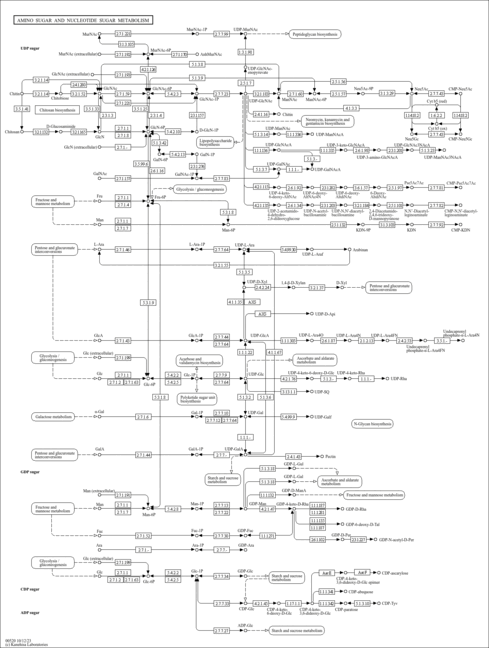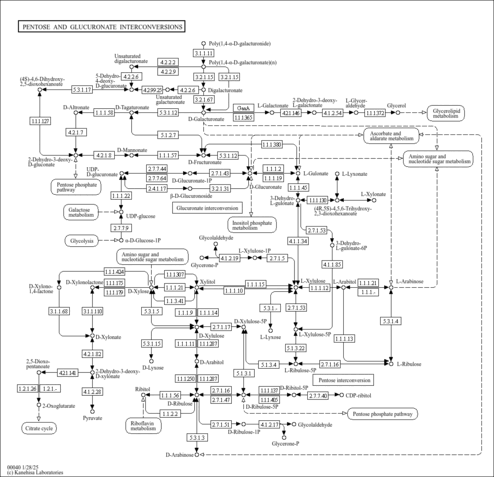| Identification |
|---|
| YMDB ID | YMDB00893 |
|---|
| Name | L-Arabinose |
|---|
| Species | Saccharomyces cerevisiae |
|---|
| Strain | Baker's yeast |
|---|
| Description | L-Arabinose, also known as L-arabinopyranose, belongs to the class of organic compounds known as pentoses. These are monosaccharides in which the carbohydrate moiety contains five carbon atoms. L-Arabinose is an extremely weak basic (essentially neutral) compound (based on its pKa). L-Arabinose exists in all living species, ranging from bacteria to humans. |
|---|
| Structure | |
|---|
| Synonyms | - Arabinose
- L-(+)-arabinose
- L-arabinopyranose
- L Arabinose
- Pectinose
|
|---|
| CAS number | 5328-37-0 |
|---|
| Weight | Average: 150.1299
Monoisotopic: 150.05282343 |
|---|
| InChI Key | SRBFZHDQGSBBOR-HWQSCIPKSA-N |
|---|
| InChI | InChI=1S/C5H10O5/c6-2-1-10-5(9)4(8)3(2)7/h2-9H,1H2/t2-,3-,4+,5?/m0/s1 |
|---|
| IUPAC Name | (3R,4S,5S)-oxane-2,3,4,5-tetrol |
|---|
| Traditional IUPAC Name | L-arabinopyranose |
|---|
| Chemical Formula | C5H10O5 |
|---|
| SMILES | [H]OC1([H])OC([H])([H])[C@]([H])(O[H])[C@]([H])(O[H])[C@@]1([H])O[H] |
|---|
| Chemical Taxonomy |
|---|
| Description | belongs to the class of organic compounds known as pentoses. These are monosaccharides in which the carbohydrate moiety contains five carbon atoms. |
|---|
| Kingdom | Organic compounds |
|---|
| Super Class | Organic oxygen compounds |
|---|
| Class | Organooxygen compounds |
|---|
| Sub Class | Carbohydrates and carbohydrate conjugates |
|---|
| Direct Parent | Pentoses |
|---|
| Alternative Parents | |
|---|
| Substituents | - Pentose monosaccharide
- Oxane
- Secondary alcohol
- Hemiacetal
- Oxacycle
- Organoheterocyclic compound
- Polyol
- Hydrocarbon derivative
- Alcohol
- Aliphatic heteromonocyclic compound
|
|---|
| Molecular Framework | Aliphatic heteromonocyclic compounds |
|---|
| External Descriptors | |
|---|
| Physical Properties |
|---|
| State | Solid |
|---|
| Charge | 0 |
|---|
| Melting point | 158-160 °C |
|---|
| Experimental Properties | | Property | Value | Reference |
|---|
| Water Solubility | 500.0 mg/mL [MERCK INDEX (1989)] | PhysProp | | LogP | -3.02 [HANSCH,C ET AL. (1995)] | PhysProp |
|
|---|
| Predicted Properties | |
|---|
| Biological Properties |
|---|
| Cellular Locations | |
|---|
| Organoleptic Properties | Not Available |
|---|
| SMPDB Pathways | | Amino sugar and nucleotide sugar metabolism | PW002413 |    |
|
|---|
| KEGG Pathways | | Amino sugar and nucleotide sugar metabolism | ec00520 |  | | Pentose and glucuronate interconversions | ec00040 |  |
|
|---|
| SMPDB Reactions | Not Available |
|---|
| KEGG Reactions | |
|---|
| Concentrations |
|---|
| Intracellular Concentrations | Not Available |
|---|
| Extracellular Concentrations | Not Available |
|---|
| Spectra |
|---|
| Spectra | | Spectrum Type | Description | Splash Key | View |
|---|
| Predicted GC-MS | Predicted GC-MS Spectrum - GC-MS (Non-derivatized) - 70eV, Positive | splash10-05al-9300000000-73d0d716ea47fc77a7ae | JSpectraViewer | | Predicted GC-MS | Predicted GC-MS Spectrum - GC-MS (4 TMS) - 70eV, Positive | splash10-00g0-9256300000-ae2d57025e3828494249 | JSpectraViewer | | Predicted LC-MS/MS | Predicted LC-MS/MS Spectrum - 10V, Positive | splash10-0ue9-1900000000-07783f4be8db8a14f6f0 | JSpectraViewer | | Predicted LC-MS/MS | Predicted LC-MS/MS Spectrum - 20V, Positive | splash10-0f89-1900000000-510acee1186ebf4c526b | JSpectraViewer | | Predicted LC-MS/MS | Predicted LC-MS/MS Spectrum - 40V, Positive | splash10-07s1-9100000000-ff1e6f260ccdb7260ded | JSpectraViewer | | Predicted LC-MS/MS | Predicted LC-MS/MS Spectrum - 10V, Negative | splash10-0002-2900000000-f624316a77fb9d1bc74f | JSpectraViewer | | Predicted LC-MS/MS | Predicted LC-MS/MS Spectrum - 20V, Negative | splash10-001j-4900000000-768143fc08314c41644f | JSpectraViewer | | Predicted LC-MS/MS | Predicted LC-MS/MS Spectrum - 40V, Negative | splash10-0006-9000000000-13182c55ee979014fcfa | JSpectraViewer | | 1D NMR | 1H NMR Spectrum | Not Available | JSpectraViewer | | 2D NMR | [1H,13C] 2D NMR Spectrum | Not Available | JSpectraViewer |
|
|---|
| References |
|---|
| References: | - Herrgard, M. J., Swainston, N., Dobson, P., Dunn, W. B., Arga, K. Y., Arvas, M., Bluthgen, N., Borger, S., Costenoble, R., Heinemann, M., Hucka, M., Le Novere, N., Li, P., Liebermeister, W., Mo, M. L., Oliveira, A. P., Petranovic, D., Pettifer, S., Simeonidis, E., Smallbone, K., Spasic, I., Weichart, D., Brent, R., Broomhead, D. S., Westerhoff, H. V., Kirdar, B., Penttila, M., Klipp, E., Palsson, B. O., Sauer, U., Oliver, S. G., Mendes, P., Nielsen, J., Kell, D. B. (2008). "A consensus yeast metabolic network reconstruction obtained from a community approach to systems biology." Nat Biotechnol 26:1155-1160.18846089
|
|---|
| Synthesis Reference: | Whistler, Roy L.; Schweiger, Richard. Preparation of D-arabinose from D-glucose with hypochlorite. Journal of the American Chemical Society (1959), 81 5190-2. |
|---|
| External Links: | |
|---|


